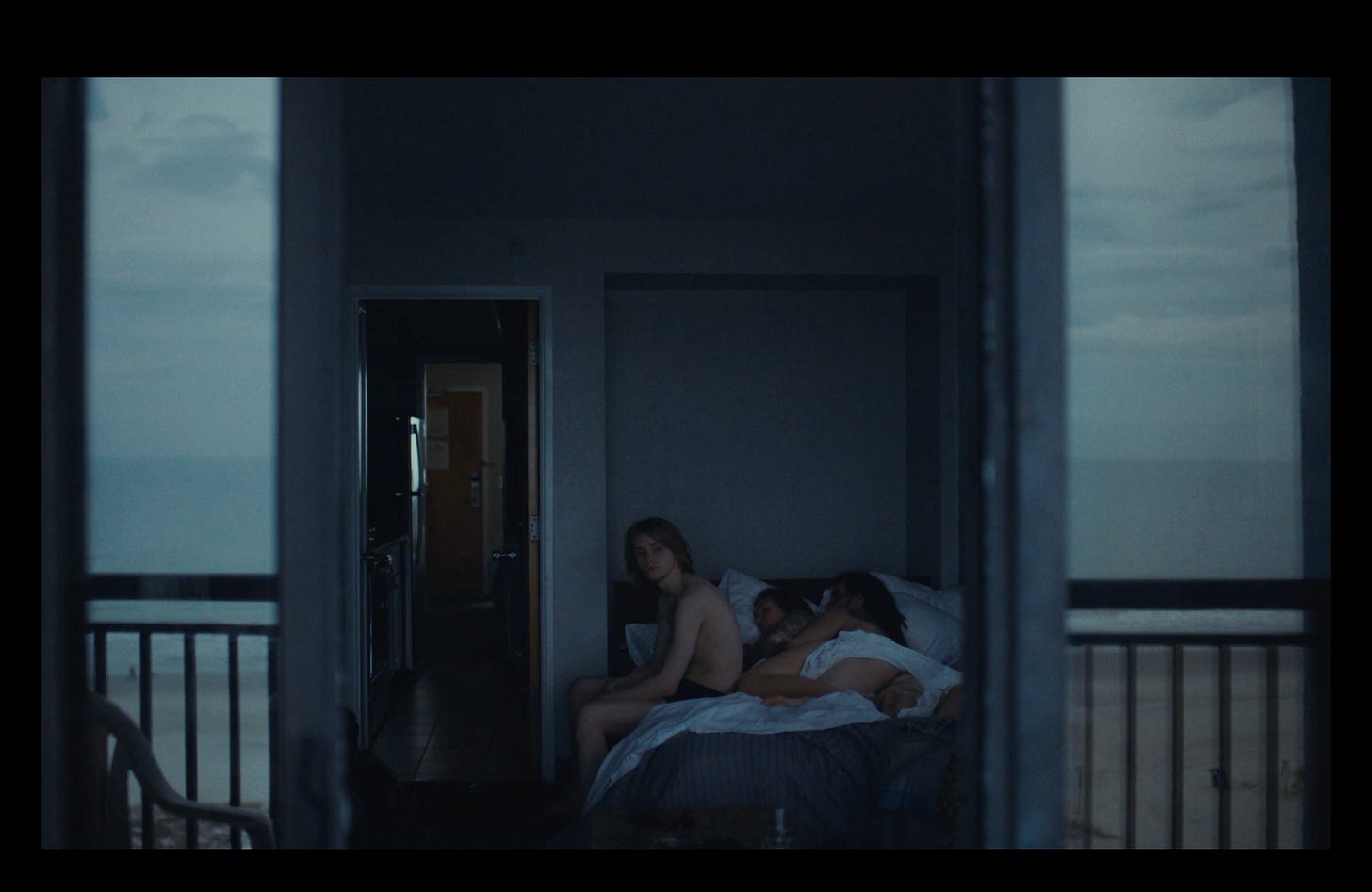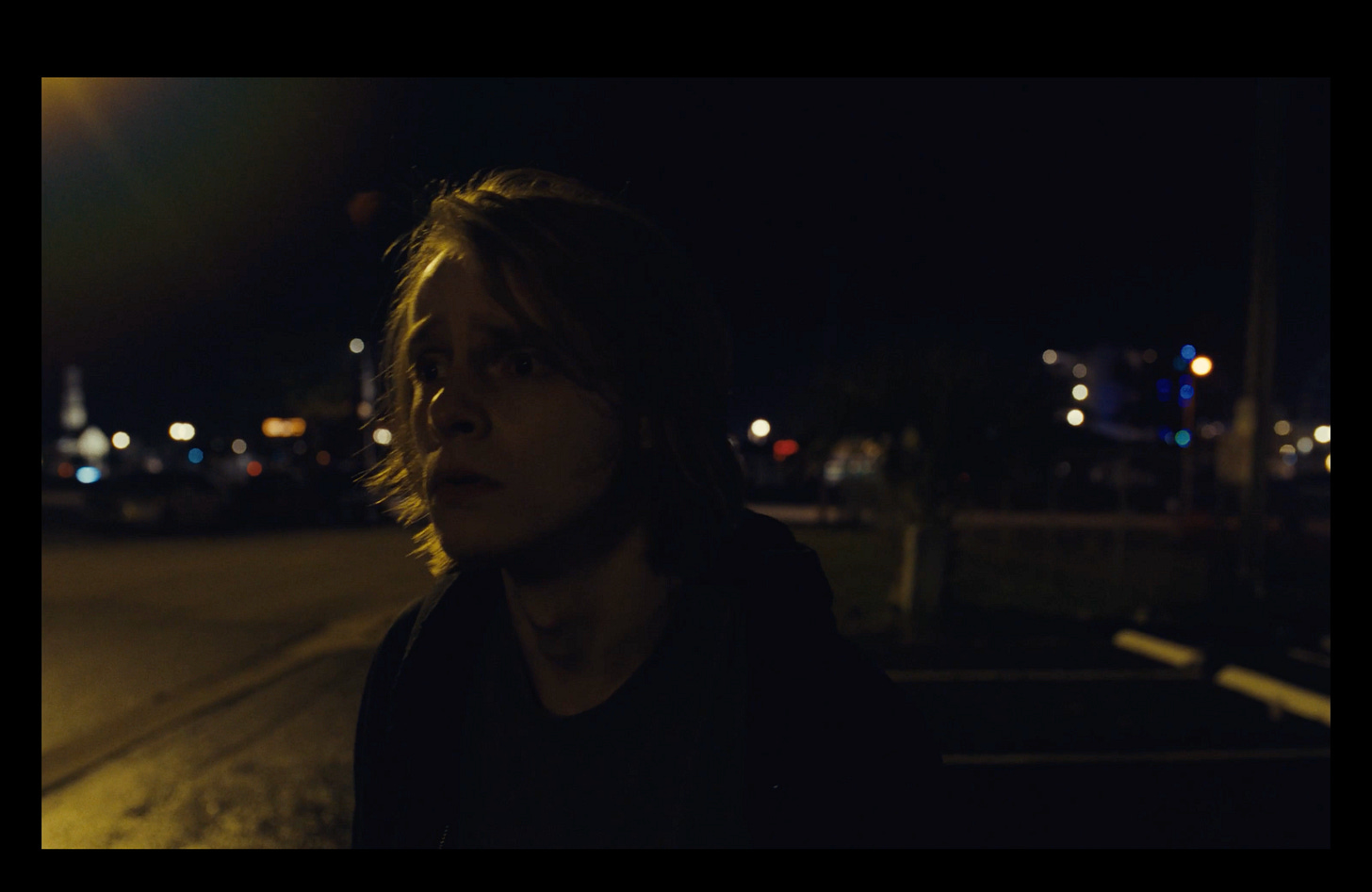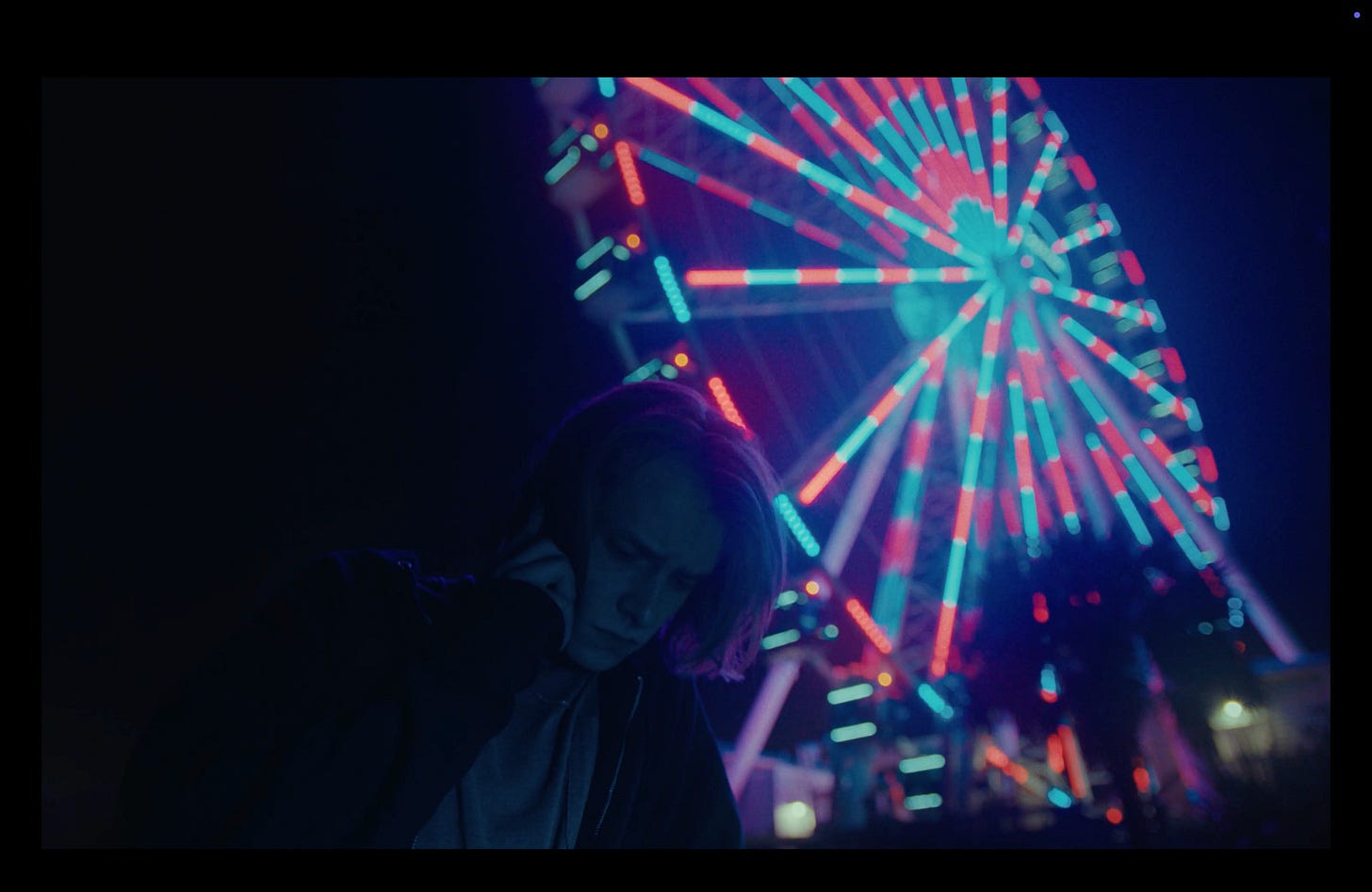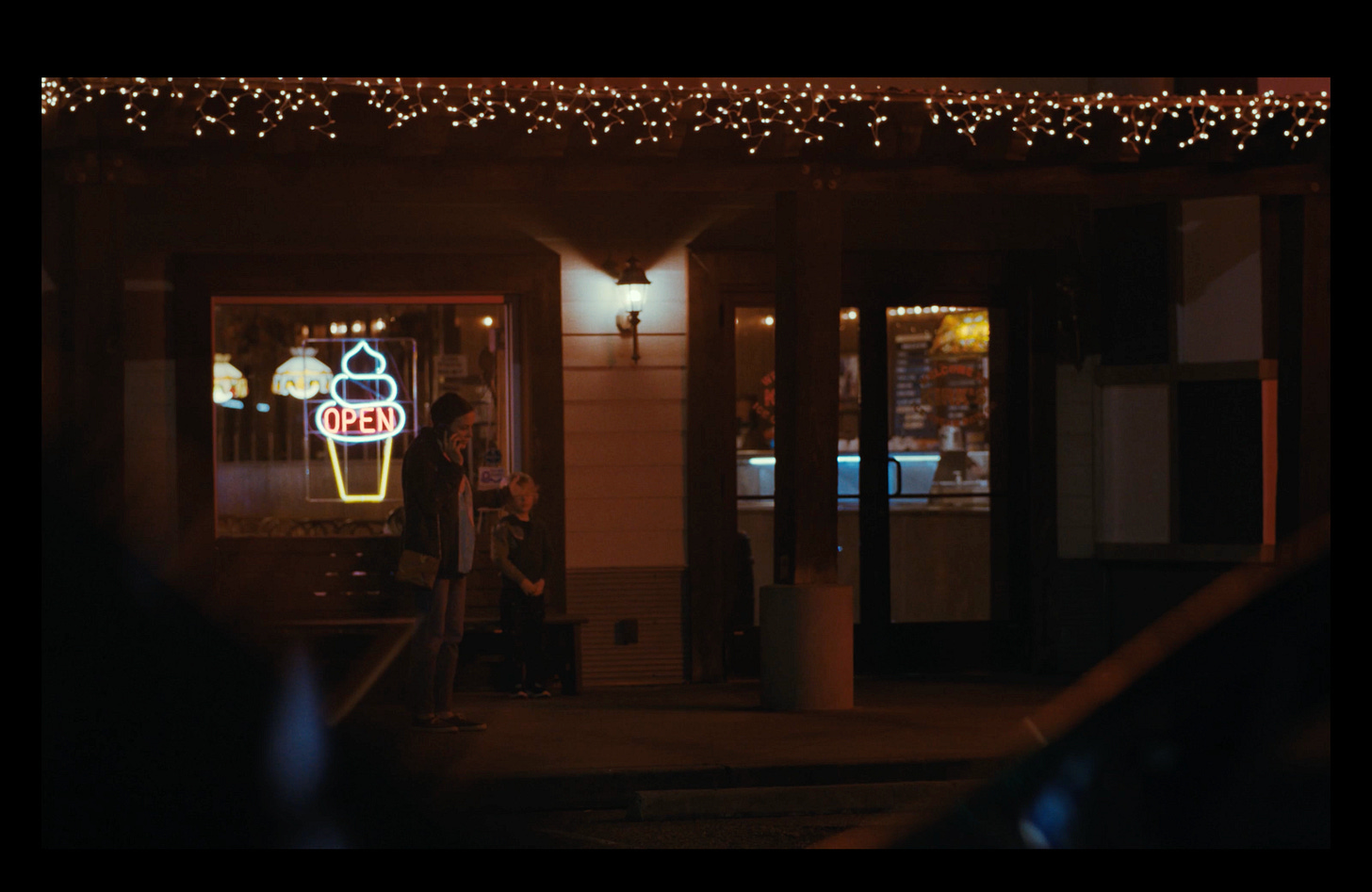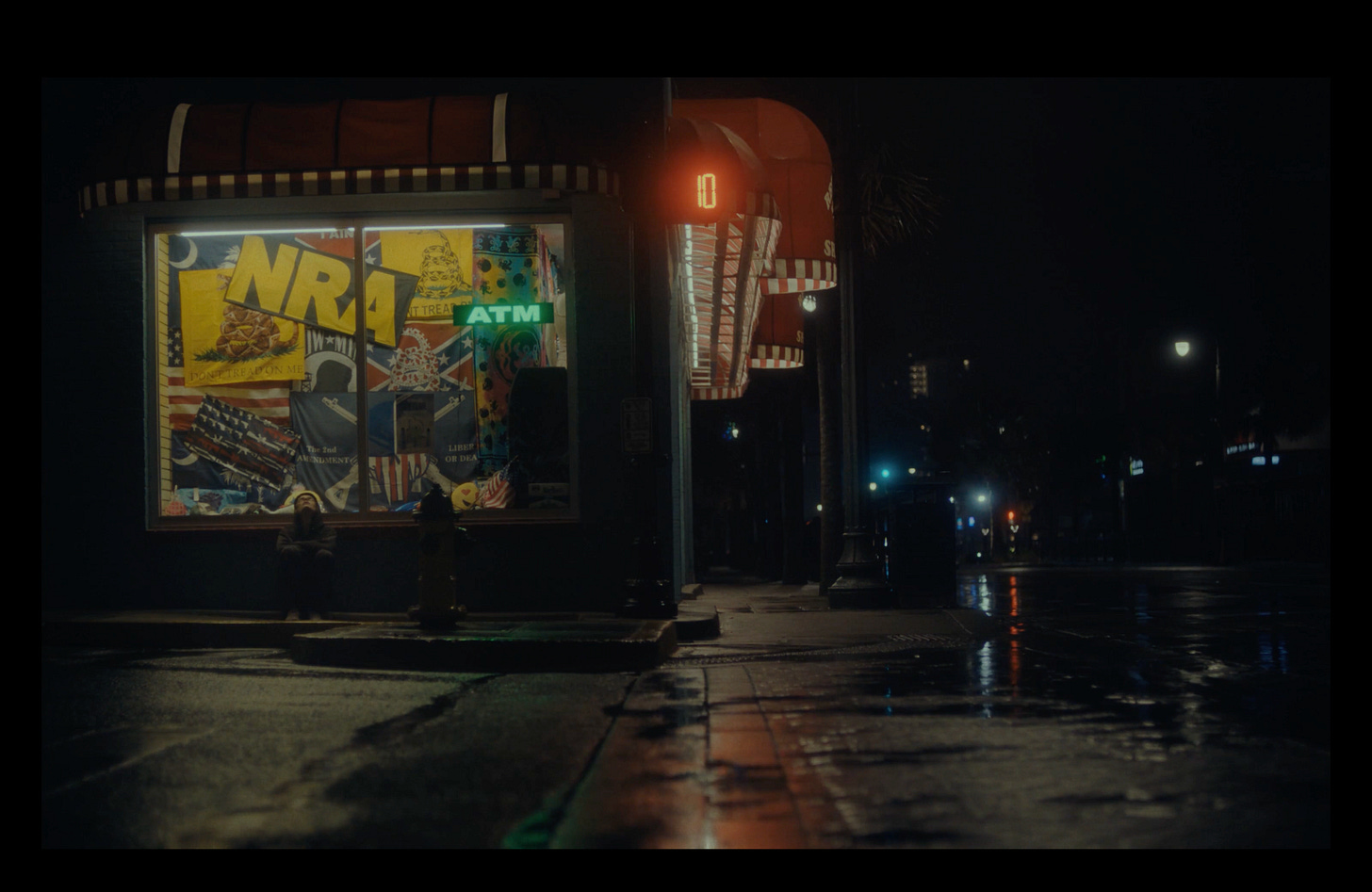Frame by Frame: 'Summer's End'
Grant and Adam Conversano break down seven key frames from their new Myrtle Beach-set drama.
Grant and Adam Conversano grew up in North Carolina, and in the summer their family would take trips to Myrtle Beach. The city’s colors and texture always felt cinematic. All the more so, a few years ago, when Grant found a post on Craigslist Myrtle Beach’s “seeking arrangements” section that piqued their interest. An older couple on vacation was looking to sleep with an 18 - 21 year-old male. “I was like, ‘This is very interesting,’” Grant remembers. “‘Where would this person be staying?’ And then [I thought about] that idea of the liminal space where all these hotels are — the stories between different hotel rooms and different people coming down here.”
The siblings, who frequently work together, set about writing a script that pulled from their own memories, friends’ experiences, and ideas about contemporary America. It shifted from a story that prominently featured the older, seeking couple, to one that was solely about the young man who joins the couple for a night while on vacation with his own family. That short, Summer’s End, premiered online last week through Filmmaker Magazine and Vimeo Staff Picks. Recently, the Conversanos and I discussed seven key frames from the film and the choices that inspired them.
This first image is what the movie opens on, and it's beautiful, with the room centered and the beach outside to the sides. Can you tell me about constructing it?
Adam Conversano: There's a family-owned hotel that our crew stayed at. This was one of the rooms in that hotel. We told them we were looking for a room to shoot in and they showed us around and we found this place with this older style room with a Murphy bed that went into the recessed wall there. And we went there with our DP, Greta Zozula to think about a bunch of different set-ups. We covered this room and this moment with a few different angles. But there was something about seeing the outside world and the inside world that we liked about this frame. Practically speaking, the camera is set up on a balcony. It's the only way you can see every aspect of this room — the beach, the exit where he's at in the middle and deciding where to go. So that's why we landed on this as our first image — it's this moment where he hasn't made a choice quite yet.
There's so much in his body language. Was that direction from you guys?
GC: Yes and no. Sometimes directing is rolling and waiting until the actor gets extremely bored. Not in the David Fincher thing of doing eighty takes until they open the door right. But we're trying to emulate an intimate moment at sunrise, and the sun is actually going down and there's a whole crew of people, so how do you create this sense of intimacy? So really it was calling action and just waiting and in that space where the camera is rolling and the crew isn't moving around and people aren't on their phones, there's a silence that falls. In the edit we found this moment where Graham is really resting between takes. Not thinking or acting, just being in the moment. And when people are living in the moment when the cameras are rolling that's when it really feels like something's happening. Even just a few frames this way or that way in the edit it didn't feel right.
This next image features Maria Dizzia's character leading grace at dinner. The colors in this shot are much more warm than in the first shot I pulled up. But they're working in the same tone. So tell me about building that tone and color palette.
GC: It's a mix of films we were inspired by, and memories tied to that place. And then executing that with the cinematography, production design, and coloring. We were thinking about filmmakers like Hamaguchi with Drive My Car, and, but also Edward Hopper and other painters
AC: And Eliza Hittman’s films as well.
GC: Yeah. We wanted something that was naturalistic and stylized, which is a really hard balance.
AC: There was also something inherent to the place of Myrtle Beach, which is to say that it's February and the light is a cooler, whiter tone. And these buildings have been there since the '50s, and they're very sprawling, pastel colors that have faded over the years. So there's an aspect of seeking out this environment specifically to shoot here for that reason. Then it was just finding a way to integrate the story and the characters in that environment and the colors in that world.
GC: Specifically with this shot I have to give all the credit to our cinematographer Greta Zozula and our key grip Trevor Hart. One crew member was sick and wasn't able to go to set, so Trevor stepped in as the gaffer and the key grip and the dolly grip. We had talked to Greta about how we wanted to cover this scene, but this shot wasn't storyboarded or anything. We were getting coverage and Greta saw the shot of Maria and I remember her moving the dolly over. Even though people were stressed and we were pushing on time, she goes, "I think you're going to want this." It's one of my favorite frames of the movie.
Tell me about working with Maria.
GC: She was amazing. We didn't know each other. Michael Abbott Jr gave her the script, she read it and agreed to meet with us She was like, "I love the script. I'm getting off of Broadway and going straight into Marvel, so I have two weeks. If you can make it happen, let's do it." So the movie went from, "Oh, we have a script, we have an idea we're trying to move along" to "It's got to happen in this window or it's not going to happen." In a good way, the film felt real once she trusted us and came on. And the conversations we had with her were super informative. She has a daughter of her own, and those conversations helped inform her character's behavior with the two kids. It helped influence other scenes, too. She's a really generous actor.
Why her? Did she remind you of your mom?
GC: I would say no in the sense that the character Maria is playing in this film really is far away from her personality. I trusted that Maria was a great actor and I knew of her work. But as we discussed working on this, she brought a lot to crafting this character with us. All of these choices added up to her being this woman that she's very far apart from. I think that was an interesting challenge for her. We talked about how to get in the headspace of a Southern conservative woman in this context and place. That's not Maria.
Next I pulled this image at the arcade on the beach. Anyone who grew up going to the beach in the summer, I feel like there's some version of this. And other than it being a beautiful image, it's striking how there's this very adult, dramatic story happening within this family, and then it's juxtaposed with this very innocent, child-centered setting.
AC: I think that's what we were very interested in generally about looking at a family drama set at Myrtle Beach. It's a place we had a lot of experiences going to in real life. But also the texture of the city was very compelling. This scene was actually supposed to be at an aquarium.
GC: Rippley's Aquarium dropped us the day of shooting. We locked that location and then the manager came out and was like, "You're absolutely not bringing a dolly into the aquarium.” I get it. But it was really scary. We didn't have a location. So Luke Lowder, who's also a director, drove around and found this location.
AC: We just walked up to this place and asked if we could bring twenty people, cameras, and lights to this location in an hour. And they were like, "Well, there's no one here, so sure."
GC: This couldn't have happened in the summer. But it was the tail end of the offseason, so people were around and back to work but no tourists were back yet. So they were very gracious hosts. We had to come in and figure this scene out. When there was no time to think about anything, we just had to fall back on those subconscious themes we were talking about in prep. And Greta and Adam found this shot and we just went with it. There was truly no planning. We had to find it immediately, and it emerged.
It sounds like you’re both very trusting of your collaborators.
AC: Yeah. There was no other way this was going to get made other than leaning on people we worked with. We spent a very long time on the story. I also constantly think about how long we spent planning out certain shots in advance that when we got on set, Greta would just put the camera somewhere else and it would tell the story in one shot rather than six. It made every decision better. It made the story sharper.
GC: But it all fell within certain rules. Even if we were behind and running out of time, we never picked up the camera and went handheld Even if we don't have time, we're going to shoot as locked off as we can and the camera is only going to move if it has to, and it's going to move on a steadicam. Within these rules that we set up, things changed a lot. But the visual constraints that we were focused on stayed constant. I think that's why the film feels cohesive even though a lot changed.
There are a couple of steadicam moments in the film. Here's one. And there's another with Elliott on the beach. I was curious where steadicam comes in and what it means to you when it does come in.
GC: There are films that have been successful with handheld — and films I like. But I think it's become somewhat of a crutch and cliche for lower budget movies. And I just felt if we could see these characters moving through space with a bit more distance and steadiness allowed for a different feeling than the hyperpresent anxiety that close handheld can provide.
AC: A big part of what we were talking about in this being about a family and addiction and alcoholism is that the only way to look at the situation with a sense of clarity is to take a step back rather than fully being subjective to one person's experience. Everyone in this family is completely unaware of each other. Especially Elliott's character. He's stumbling into understanding what's happening with his family and there are things the camera sees that he isn't necessarily seeing. We wanted the camera to find a bit more empathy than Elliott might in a given moment.
And then in these moments where you do introduce the steadicam and some movement, I'm guessing that's to emphasize certain dramatic moments and Elliott's movement away from something or towards something.
GC: Totally. And then there was one scene that was on a dolly taking the father outside to the car. I think it's just trying out a more classical language. When you look at, say, an Edward Hopper painting, the people in it are ostensibly miserable or lonely or in between. But you're not really thinking about that. You're just looking at people in spaces. That was a big reference because even if you're feeling miserable you're probably standing in a beautiful situation you might not even be able to see.
It seems like there was a lot of planning but then also ditching the plan while sticking to certain rules. And I'm curious what and how you communicated to Greta.
GC: It was specific. There was a feature film a number of years ago that Greta was the DP and I was a camera assistant. So we would talk about lenses and the gear and the focal lengths. But as the production was challenging and things came up, Greta was also one of the most experienced people on set having shot films and television. So we were able to pivot and figure out these moments on the fly while sticking to the visual language we all developed together.
In moments when it did get difficult, did you have a process for taking a step back and figuring things out.
AC: I mean, quite literally it was a matter often of just physically stepping back from where the frame was. I have a background in visual art and my experience with that from a painting school was that if you're spending so much time painting and you don't know what to do, it's because your face is inches from the canvas and you're losing your mind trying to figure out what to do next. The solution often was to go to the other side of the room to get a wider view and sit over there until you figure out what to do next. And there was a lot of doing that. And sometimes it would be like, "Why don't we just do this in one shot like this," and that would cut an hour of setup time and three shots. And then we could move forward. And that just requires spending five minutes taking a step back and thinking rather than spending an hour pushing forward in the wrong direction.
There's a lot of Elliott on the phone in the movie. Was that intentional or just happenstance?
GC: That was part of the script. And then you go, "OK, I have to make a phone call look interesting." And that can be challenging.
Well it helps to have this amazing ferris wheel in the background or some of these other beach tableaus. Here, we have the ice cream shop. How much of this exterior were you designing?
GC: Those Christmas lights were there.
AC: I remember talking to Greta about those glares. There was one naturally on the right. And then she was like, "What color should the one on the left be?"
GC: The red hue was made by the crew. There were two big lights with gels that accentuated the feeling of the neon warmth. But there was neon lighting that brought that up and made it more heightened.
This image says so much. It's this interesting juxtaposition with all the childlike imagery in the film. Tell me about finding this and scripting it and the idea it communicated.
GC: This beach shop has been there since we were kids and the window has been exactly the same. That's sort of the contradiction that plays out across the South, but is maybe heightened in a place like Myrtle Beach. You see all these amusement parks and cotton candy, but mixed in with Confederate flags and "Don't Tread on Me" signs. It was a confusing, strange place to grow up. It's only now getting older and moving to New York that you realize that's not every beach. That was obviously seared in our memory. And this shot was pretty specific. Adam drew it early on. This one we thought about for at least a year.
And there's also this element of this family on a vacation that should be this idyllic moment but instead is turbulent and dramatic and dark.
GC: I remember seeing some of Joanna Hogg's films. That was an early spark to be like, "Oh, the vacation is a really interesting context for a family drama. This film is different from hers. But she also has this austere, distancing camera work.
Even if this film isn't completely autobiographical, it's very personal and I'm curious about the process of doing that collaboratively.
AC: I think we worked on this for a number of years in terms of the writing and thinking about what we're going after. And it was also a matter of saying, "OK, what are the parts of our experience that are universal? And what are other parts that ultimately help us create a narrative film get at some of these themes and that have space for an audience?" So I think it was a big part of not just us thinking about our own experience, but also what we see happening in this region and in the country right now. And how can our experience be a venue to talk about those things?
GC: There were lots of people who we grew up with who we talked to who had different versions of going to Myrtle Beach. Some of it came from observation. In the South, it can be hard to be openly queer or finding yourself. And a lot of other families we grew up with had similar explosive vacations. And we'd talk about those stories.
I'm also curious about your style of working together. How do you complement each other in the filmmaking process?
AC: In the filmmaking process, there's always five things to do at once. If there's one of you, you only do one of them. If there's two of you, you can do two of them. Together we covered a lot of ground. We took turns working with actors, dealing with production, and setting up a frame with Greta. We all know what the larger mission is, and we'll take a triage of addressing different things. I think a lot of it comes from having prepped so much in advance.
Listings
Mudslide, a short film produced by Bre Thomas, is casting for the roles of Sam (Female, 25 - 35, Black) and Jesse (Female, 18 - 25, white). Shooting outside of Seattle in May. Open to anyone in U.S. Paid + travel. No acting experience required. Email stellatompkindscasting@gmail.com for more info.
LA Festival of Movies is back April 3 - 6. Tickets, passes, and more here.
Max Cea (me, yes, hi!) just finished principal photography on The Big Game, a feature he was a producer on. He is back in NY and open to work.
No Film School recently published a massive list of spring film grants, labs, and fellowships. Check it out here.
Eli Barry is looking for work. Eli is a media production pro specializing in visual media and content, including work at Marvel Entertainment. He has produced award-winning short films, music videos, and commercial content. Email me@elijahbarry.com.
Aaron Schoonover is a Casting Director available for your short or indie feature. Able to cast remotely out of various hubs. Flex rate sliding scale for all budgets. Experience casting on studio projects and super indie projects! Email schoonovercasting@gmail.com.
Applications are open for the Jerome NYC Film Production Grant. Deadline is April 3. Supports NYC-based early career filmmakers working in short or long form, experimental, narrative, animation, doc, or any combination of genres. Up to $30K available.
If you would like to list in a future issue, either A) post in the Nothing Bogus chat thread, or B) email nothingbogus1@gmail.com with the subject “Listing.” (It’s FREE!) Include your email and all relevant details (price, dates, etc.).





